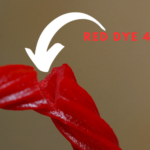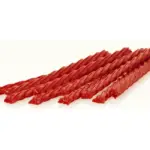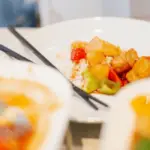Skittles are a popular candy that has been enjoyed since 1974 when they were invented in the United Kingdom. They are small, colorful, and come in a variety of flavors.
When most people look inside a bag of Skittles, they realize that the candy’s vibrant colors likely aren’t natural. However, one question that often comes up is whether Skittles have Red Dye 40 in them.
Here you will learn what gives Skittles their color and specifically, if that color comes from Red Dye 40. Let’s get into what you need to know about the dyes used to color Skittles.
Is There Red Dye 40 in Skittles?
Skittles do contain Red Dye 40, along with other artificial dyes.
According to the table below, all Skittles products listed contain Red Dye 40, including popular Skittles flavors like Original, Wild Berry, Sour, Brightside, Tropical, and Smoothies.
In addition to Red Dye 40, Skittles also contain other artificial coloring, including Yellow 5, Yellow 6, Blue 1, Blue 2, and Titanium Dioxide. See the dyes used in each Skittles product in the below table.
| Skittles Product | Red Dye 40 (Yes or No)? | Artificial Coloring Used? |
|---|---|---|
| Original | Yes | Red 40 Lake, Yellow 5 Lake, Blue 2 Lake, Yellow 6 Lake, Titanium Dioxide, Blue 1 Lake, Yellow 6, Red 40, Yellow 5, Blue 1. |
| Wild Berry | Yes | Titanium Dioxide, Red 40 Lake, Blue 2 Lake, Yellow 5 Lake, Blue 1 Lake, Red 40, Yellow 5, Blue 1, Yellow 6. |
| Sour | Yes | Red 40 Lake, Yellow 5 Lake, Blue 2 Lake, Yellow 6 Lake, Titanium Dioxide, Blue 1 Lake |
| Brightside | Yes | Titanium Dioxide, Blue 1 Lake, Yellow 5 Lake, Yellow 6 Lake, Red 40 Lake, Yellow 6, Yellow 5, Red 40 |
| Tropical | Yes | Yellow 5 Lake, Yellow 6 Lake, Blue 1 Lake, Red 40 Lake, Titanium Dioxide, Blue 1, Yellow 6, Red 40. |
| Smoothies | Yes | Red 40 Lake, Yellow 5 Lake, Yellow 6 Lake, Blue 2 Lake, Titanium Dioxide. |
| Original Gummies | Yes | Red 40, Yellow 5, Yellow 6, Blue 1. |
| Wild Berry Gummies | Yes | Red 40, Yellow 5, Blue 1. |
About Red Dye 40
Red Dye 40 is a common food dye that is used in many processed foods, including candy, beverages, and baked goods. It is a synthetic color that is derived from petroleum and is approved by the FDA for use in food.
However, some studies have suggested that Red Dye 40 may be linked to increased hyperactivity, particularly in children who have attention-deficit/hyperactivity disorder (ADHD).
Some people are also purportedly allergic to Red 40 with potential side effects including hives, asthma, sneezing, skin irritation, and more.
Lastly, research has discovered that high doses of dye given to animals caused tumor growth from a substance called benzene found in the Red 40. However, it is believed that the amount of benzene that humans consume in food is too minimal to be considered high-risk.
While we won’t list the concerns with the other synthetic dyes used in Skittles, be aware that there are also similar concerns as with Red 40. In other words, if you desire to avoid Red 40 you should potentially also look into avoiding the other dyes found in Skittles as well.
Final Thoughts
Skittles do contain Red Dye 40 and other artificial dyes. While these dyes are approved by the FDA for use in food, some studies have suggested that they may be linked to health problems, particularly in children.
As with any processed food, it is important to consume Skittles in moderation and be aware of the ingredients they contain. If you are concerned about the use of artificial dyes in your food, you may want to consider choosing food and beverages without these dyes.
The ingredients listed on the product label are your best source to determine if a food has artificial dyes. The dyes will be disclosed in the ingredient list for packaged foods sold in U.S. grocery stores.
References:
skittles.com
Cleveland Clinic. (2023, April 6). Is Red Dye 40 safe?. Cleveland Clinic. https://health.clevelandclinic.org/red-dye-40/







